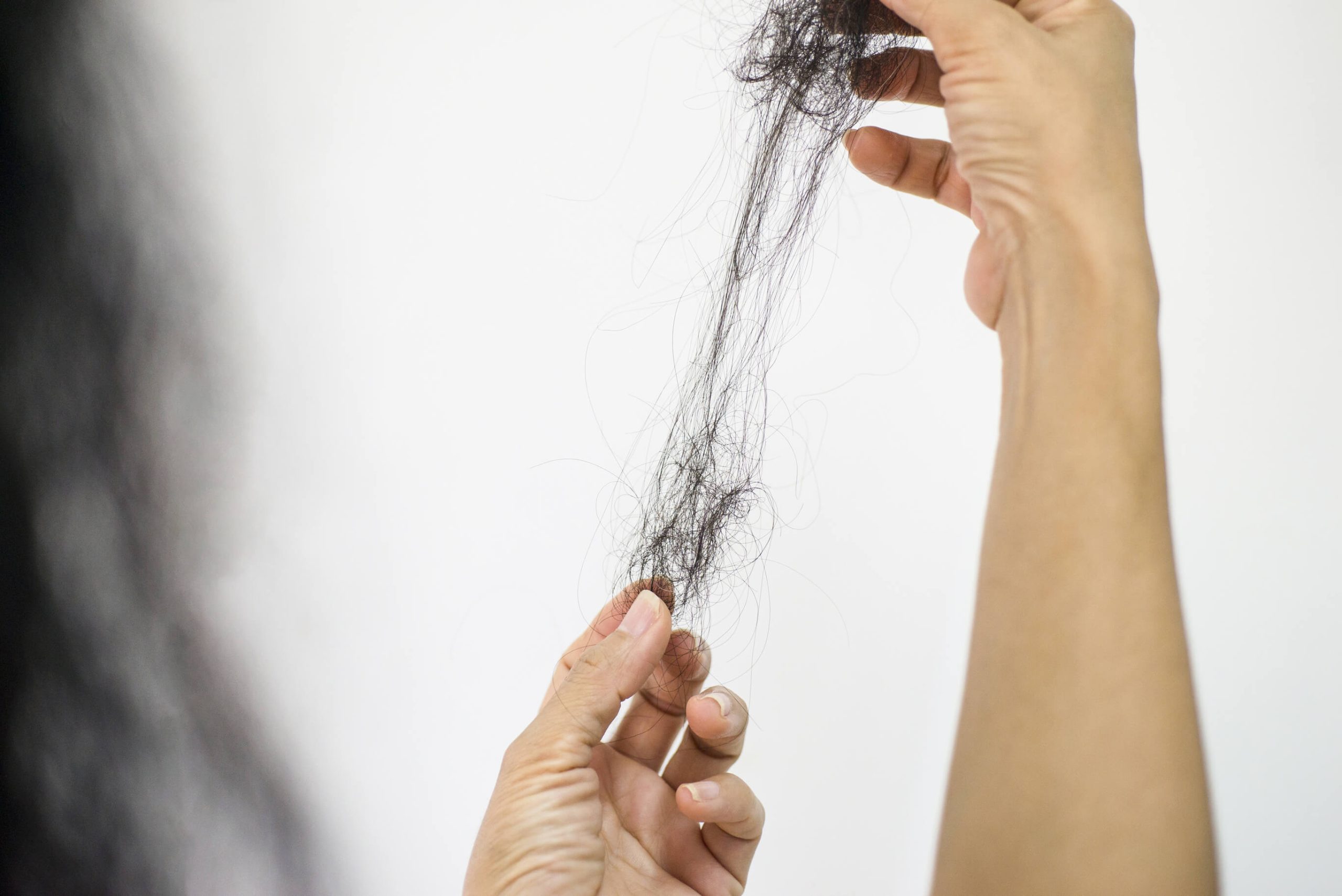Hair shedding is a natural part of the hair growth cycle. On average, it’s normal to lose between 50 to 100 strands of hair daily. However, many people, including women, experience anxiety when they notice clumps of hair in the shower drain, fearing they may be losing too much hair. Everyone seeks advice from a doctor or turns to various hair products and treatments, hoping to address the issue. Understanding how much hair loss is normal and when it might be a cause for concern is essential for maintaining your hair health. Whether it’s the person noticing changes in their hair or considering a new shampoo or body care routine, a lot of advice can be found to help manage and reduce hair shedding effectively.
Understanding Hair Shedding: The Basics
Hair shedding can be alarming, especially when you see clumps of hairs after a shower. However, understanding the reasons behind hair loss, the way hair follicles function, and the various treatments recommended by an MD can help alleviate concerns. Studies have shown that some hair loss is entirely normal and a natural part of the hair growth cycle, ensuring the health of your head and overall body. Whether you’re seeking advice on the best shampoo or exploring different treatment options, it’s important to recognize that everyone experiences some degree of hair shedding.
The Hair Growth Cycle
Hair grows in cycles, and each hair follicle is at a different stage at any given time. The three main stages of the hair growth cycle are:
- Anagen Phase: The growth phase, lasting anywhere from 2 to 7 years.
- Catagen Phase: The transitional phase, lasting around 10 days.
- Telogen Phase: The resting phase, which lasts about 3 months before the hair is shed.
This cycle means that hair is constantly growing, resting, and shedding. The telogen phase is when you’ll notice hair shedding, which is why it’s normal to see strands of hair falling out, particularly in the shower when you’re washing and combing your hair.
Normal Hair Shedding in the Shower
Hair loss treatment in the shower is normal, as shedding is a natural process. Experts and dermatologists say losing 50 to 100 strands daily is typical, increasing to around 150 strands on wash days. This pattern is normal across different hairstyles and growth phases. Washing less often might make it seem like you’re losing more hair due to accumulated shedding. Both men and women may wonder about this and how to manage it. To alleviate concerns, consider discussing with dermatologists or reading relevant articles on hair health. Research can also help in understanding the underlying causes.
Factors That Influence Hair Shedding
There are several factors that can influence how much hair you lose in a water shower. Understanding these factors can help you determine whether your hair shedding is within the normal range or if there might be an underlying issue requiring further diagnosis. News and tips from experts, often found on a reliable site or in a newsletter, can offer content to address these concerns. If you’re a woman noticing changes in your hairline or have a pressing question about your hair, it’s crucial to consider aspects like conditioning, life changes, and the point in time when the shedding occurs. Sometimes, something as simple as adjusting your hair care program or routine can make a significant difference. Looking at your hair in the mirror can be the top indicator of whether the shedding is normal or if it’s time to seek professional advice.
1. Hair Texture and Volume
Hair texture and volume can play a significant role in how much hair you lose in the shower. Those with thicker, curlier hair might lose more strands due to the increased tangling and breakage that can occur during washing and brushing. On the other hand, people with finer hair might not notice as much hair shedding.
2. Hair Care Routine
Your hair care routine, including how often you wash, comb, and brush your hair, can also affect how much hair you lose. If you comb or brush your hair when it’s wet, you might see more hair loss because wet hair is more prone to breakage. Similarly, using a conditioner can help reduce breakage and shedding by making the hair easier to detangle.
3. Hormones and Diet
Hormones and diet also play a crucial role in hair shedding. Hormonal changes, such as those experienced during pregnancy, menopause, or when starting or stopping birth control, can lead to increased hair shedding. Additionally, a diet lacking essential nutrients like vitamins, minerals, and proteins can weaken hair strands, leading to more hair loss.
4. Genetics and Health Conditions
Genetics play a significant role in determining how much hair you shed. Some people are naturally predisposed to shedding more hair due to genetic factors. Additionally, certain health conditions, such as alopecia areata, telogen effluvium, or other illnesses, can lead to increased hair shedding.
When to Be Concerned About Hair Shedding
While some hair shedding is normal, there are times when it might be a sign of a more serious issue. If you notice clumps of hair in the bathroom or an unusual increase in shedding, it could indicate a problem that goes beyond the usual life cycle of hair growth. Understanding the difference between normal hair loss and excessive hair shedding, which can sometimes be seen in sources like Getty Images for illustrative purposes, can help you assess the risk and take action if needed. Whether you see this on Instagram or in patient feedback, recognizing when shedding exceeds the typical length and results in noticeable thinning or other things can guide you in seeking professional advice.
1. Signs of Excessive Hair Loss
Excessive hair damage can be characterized by losing more than 100 to 150 strands of hair per day or noticing significant thinning or bald spots. If you’re experiencing these symptoms, it might be time to consult with a healthcare provider or a dermatologist. Establishing a baseline for your hair shedding and comparing it with the typical amounts of hair loss can help determine if there’s a need for hair loss treatments. Researchers emphasize that age can be a significant factor in hair loss, and understanding your place in the hair growth cycle is essential. Paying attention to any changes, such as the form and distribution of thinning, and considering how much rest your hair gets between styling or treatments can also be crucial. If in doubt, seeking advice from a reliable source can guide you in finding the right work for managing or reversing hair loss.
2. Identifying the Cause
Identifying the cause of excessive hair loss can be challenging. It’s essential to consider factors such as recent stress, illness, medication changes, or hormonal fluctuations. A healthcare provider can help diagnose the underlying issue through a thorough examination and possibly recommend treatment or lifestyle changes.
3. When to Seek Professional Help
If you’re concerned about the amount of hair you’re losing, it’s a good idea to seek professional help. A dermatologist or a healthcare provider specializing in hair loss can help determine whether your shedding is within the normal range or if there’s an underlying condition that needs to be addressed.
Preventing and Managing Hair Shedding
While some hair shedding is inevitable, there are steps you can take to minimize hair loss and maintain healthy hair.
1. Proper Hair Care Practices
Adopting proper hair care practices can significantly reduce hair shedding. This includes using gentle, sulfate-free shampoos and conditioners, avoiding excessive heat styling, and using a wide-toothed comb to detangle wet hair. Additionally, regular trims can help prevent split ends and breakage.
2. Nutrition and Supplements
A balanced diet rich in vitamins, minerals, and proteins is essential for healthy hair. Consider incorporating foods high in biotin, iron, and omega-3 fatty acids into your diet. If necessary, talk to your healthcare provider about supplements that can support hair health.
3. Managing Stress
Stress can have a significant impact on hair health, leading to increased shedding. Incorporating stress management techniques, such as meditation, exercise, and adequate sleep, can help reduce stress-related hair loss.
4. Treatments and Medications
For those experiencing significant hair loss, treatments and medications such as minoxidil, finasteride, or PRP therapy might be recommended by a healthcare provider. These treatments can help promote hair growth and reduce further shedding.
Myths About Hair Loss
There are many myths surrounding hair loss, and it’s important to separate fact from fiction to make informed decisions about your hair care.
1. Myth: Shampooing Causes Hair Loss
Many people believe that shampooing causes hair loss, but this is not true. While you may notice more hair shedding during shampooing, this is simply due to the natural shedding process. Shampooing helps to clean the scalp and remove dead skin cells, which is essential for healthy hair growth.
2. Myth: Brushing Hair 100 Times a Day Promotes Hair Growth
Brushing your hair excessively can actually lead to more hair breakage and shedding. It’s important to be gentle when brushing your hair and avoid over-brushing, especially when the hair is wet and more prone to breakage.
3. Myth: Cutting Hair Frequently Makes It Grow Faster
Cutting your hair does not make it grow faster. Hair growth occurs at the scalp, and trimming the ends has no effect on the rate of hair growth. However, regular trims can help prevent split ends and breakage, giving the appearance of healthier hair.
Conclusion
Understanding how much hair is normal to lose in the shower is essential for maintaining hair health and preventing unnecessary anxiety. While it’s normal to lose some hair daily, excessive hair shedding can be a sign of an underlying issue that needs to be addressed. By adopting proper hair care practices, maintaining a balanced diet, managing stress, and seeking professional help from Neograft Hair Restoration Orange County when needed, you can minimize hair shedding and promote healthy hair growth.
For more information on hair loss, check out our blog posts: Can Hair Dye Cause Hair Loss, Does Working Out Cause Hair Loss, and Hair Loss Myths.
Understanding Hair Shedding: Causes, Normalcy, and Treatments – FAQs
1. How much hair is expected to shed daily?
It’s normal to shed between 50 to 100 strands of hair daily during the natural hair growth cycle.
2. Why do I lose more hair in the shower?
Hair shedding often appears more noticeable in the shower because washing loosens hair that is already in the shedding phase.
3. Does frequent shampooing cause hair loss?
No, shampooing doesn’t cause hair loss. It simply removes hair that’s already shed.
4. Can stress increase hair shedding?
Yes, stress can disrupt the hair growth cycle, leading to increased shedding, a condition known as telogen effluvium.
5. Does wet brushing cause more hair loss?
Brushing wet hair can cause more breakage and shedding, as wet hair is more prone to damage.
6. What factors affect hair shedding?
Factors like hormones, diet, genetics, and hair care routines can impact the amount of hair you shed.
7. When should I be concerned about hair shedding?
If you notice clumps of hair, bald spots, or thinning, it’s best to consult a healthcare provider.
8. Can a poor diet cause hair loss?
A lack of essential nutrients like vitamins, minerals, and proteins can weaken hair and lead to more shedding.
9. Are there treatments for excessive hair shedding?
Treatments like minoxidil, finasteride, and PRP therapy can help reduce hair shedding and promote growth.
10. Can hormonal changes affect hair shedding?
Yes, hormonal fluctuations during pregnancy, menopause, or birth control use can increase hair shedding.















Recent Comments